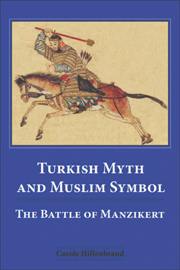Book contents
- Frontmatter
- Contents
- List of figures
- List of plates
- Acknowledgements
- Comment on transliteration and conventions used in the book
- Dedication
- Part 1 Medieval Muslim interpretations of the battle of Manzikert
- 1 Introduction
- 2 The twelfth-century accounts of the battle of Manzikert
- 3 The thirteenth-century accounts of the battle of Manzikert
- 4 The fourteenth- and fifteenth-century accounts of the battle of Manzikert
- 5 Writing the battle
- Part 2 The legacy of the battle
- Conclusion
- Appendix A The account of the battle of Manzikert by Michael Attaleiates, translated by Ruth Macrides
- Appendix B Translations of some other medieval Christian accounts of the battle of Manzikert
- Appendix C Other medieval Muslim accounts of the battle of Manzikert
- Bibliography
- Index
- Plate section
4 - The fourteenth- and fifteenth-century accounts of the battle of Manzikert
from Part 1 - Medieval Muslim interpretations of the battle of Manzikert
Published online by Cambridge University Press: 05 August 2013
- Frontmatter
- Contents
- List of figures
- List of plates
- Acknowledgements
- Comment on transliteration and conventions used in the book
- Dedication
- Part 1 Medieval Muslim interpretations of the battle of Manzikert
- 1 Introduction
- 2 The twelfth-century accounts of the battle of Manzikert
- 3 The thirteenth-century accounts of the battle of Manzikert
- 4 The fourteenth- and fifteenth-century accounts of the battle of Manzikert
- 5 Writing the battle
- Part 2 The legacy of the battle
- Conclusion
- Appendix A The account of the battle of Manzikert by Michael Attaleiates, translated by Ruth Macrides
- Appendix B Translations of some other medieval Christian accounts of the battle of Manzikert
- Appendix C Other medieval Muslim accounts of the battle of Manzikert
- Bibliography
- Index
- Plate section
Summary
The successor of Constantine, in a plebeian habit, was led into the Turkish divan, and commanded to kiss the ground before the lord of Asia. He reluctantly obeyed; and Alp Arslan, starting from his throne, is said to have planted his foot on the neck of the Roman emperor. But the fact is doubtful; and if in this moment of insolence, the sultan complied with a national custom, the rest of his conduct has extorted the praise of his bigoted foes, and may afford a lesson to the most civilised ages.
The account of Rashid al-Din (d. 717/1318) in Jāmiʿ al-tawārīkh
Introduction to the text
Rashid al-Din, the most famous Persian historian of the Ilkhanid period, served at the Mongol court and attained high office under Ghazan in 697/1298. His Universal History (Jāmiʿ al-tawārīkh) is his most celebrated work. This text forms part of the complex network of sources in the Persian historiographical tradition about the Seljuqs. The text of Rashid al-Din bears a close resemblance to that of a contemporary of his, Qashani, who wrote a history called Zubdat al-tawārīkh, but the two narratives are not identical. The version of Rashid al-Din is clearer and is helped by a good edition, whereas the text of Qashani is slightly more verbose and repetitive and is rendered difficult to read at times by a number of editorial mistakes. For the translation provided here, the version of Rashid al-Din has been followed, but from time to timea short additions from Qashani's text have been inserted into the footnotes.
- Type
- Chapter
- Information
- Turkish Myth and Muslim SymbolThe Battle of Manzikert, pp. 89 - 110Publisher: Edinburgh University PressPrint publication year: 2007



